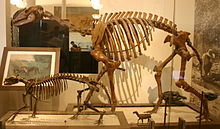Macrauchenia
| Macrauchenia | ||||||||||||
|---|---|---|---|---|---|---|---|---|---|---|---|---|

Live reconstruction of Macrauchenia |
||||||||||||
| Temporal occurrence | ||||||||||||
| Miocene to Pleistocene | ||||||||||||
| 9 million years to 11,000 years | ||||||||||||
| Locations | ||||||||||||
| Systematics | ||||||||||||
|
||||||||||||
| Scientific name | ||||||||||||
| Macrauchenia | ||||||||||||
| Owen , 1838 | ||||||||||||
Macrauchenia was one of the last representatives of the mammalian order Litopterna , one of the so-called South American ungulates (Meridiungulata). It lived in South America and died out at the end of the Pleistocene .

Appearance
With a shoulder height of 1.8 m, Macrauchenia was about the size of a camel ( Camelus ) and its habitus is likely to have been reminiscent of these animals. There were three carrying toes on the long and very strong legs, the neck was long, and the nostril on the top of the skull suggests a short trunk.
distribution
The order Litopterna originated in the middle Paleocene and gave rise to a number of genera that are reminiscent of today's horses or camels due to the elongated limbs and the reduction in the number of toes . Most of them died out after the creation of the Central American land bridge at the end of the Pliocene and the resulting exchange of fauna between North and South America , with the exception of two genera of the Litopterna, namely Windhausenia and Macrauchenia , and two species (the approximately hippopotamus- sized Toxodon and Mixotoxodon ) from the order Notoungulata, also counted among the South American ungulates .
Macrauchenia patachonica separated from the odd ungulate order around 66 million years ago and only died out at the end of the Pleistocene around 10,000–20,000 years ago. It is unlikely that this happened as a result of hunting by newly immigrated predators and competition with immigrant ungulates from North America, since with Macrauchenia at the end of the Pleistocene most of these large newly immigrated animals also disappeared, after Macrauchenia had previously lived with the new immigrants for millions of years Had lived in South America. There are finds together with the immigrated camel genus Palaeolama .
Macrauchenia remains are mainly found in the southeastern pampas , but finds are also known from Bolivia, Peru and Taima Taimai in Venezuela .
Way of life

From its geographical distribution, one can conclude that Macrauchenia was a savanna inhabitant. It is more difficult to reconstruct the feeding habits of this animal. The suspected trunk, which would have been more suitable for plucking leaves, suggests a leaf eater, while the high-crowned teeth indicate a grass eater.
species
- Macrauchenia formosa
- Macrauchenia intermedia
- Macrauchenia patachonica
- Macrauchenia ullomensis
literature
- Paul S. Martin , Richard G. Klein (Eds.): Quaternary Extinctions. A Prehistoric Revolution. The University of Arizona Press, Tucson AZ 1984, ISBN 0-8165-1100-4 .
- Arno Hermann Müller : Textbook of paleozoology. Volume 3: Vertebrates. Part 3: Mammalia. 2nd, revised and expanded edition. Fischer, Jena 1989, ISBN 3-334-00223-3 .
- Alan Turner: National Geographic Prehistoric Mammals. National Geographic, Washington DC 2004, ISBN 0-7922-7134-3 .
Individual evidence
- ↑ Michael Westbury, Sina Baleka, Axel Barlow, Stefanie Hartmann, Johanna LA Paijmans, Alejandro Kramarz, Analía M. Forasiepi, Mariano Bond, Javier N. Gelfo, Marcelo A. Reguero, Patricio López-Mendoza, Matias Taglioretti, Fernando Scaglia, Andrés Rinderknecht, Washington Jones, Francisco Mena, Guillaume Billet, Christian de Muizon, José Luis Aguilar, Ross DE MacPhee, Michael Hofreiter: A mitogenomic timetable for Darwin's enigmatic South American mammal Macrauchenia patachonica. Nature Communications 8, 2017, p. 15951, doi: 10.1038 / ncomms159 .
- ^ Alberto L. Cione, Eduardo P. Tonni, Leopoldo Soibelzon: The Broken Zig-Zag: Late Cenozoic large mammal and tortoise extinction in South America. In: Revista del Museo Argentino de Ciencias Naturales. 5, 1, 2003, ISSN 1514-5158 , pp. 1-19, ( [1] ).
Web links
- The Paleobiology Database Macrauchenia
- Image of two macrauchenias
- The riddle of the trunk camels - spectrum of science.